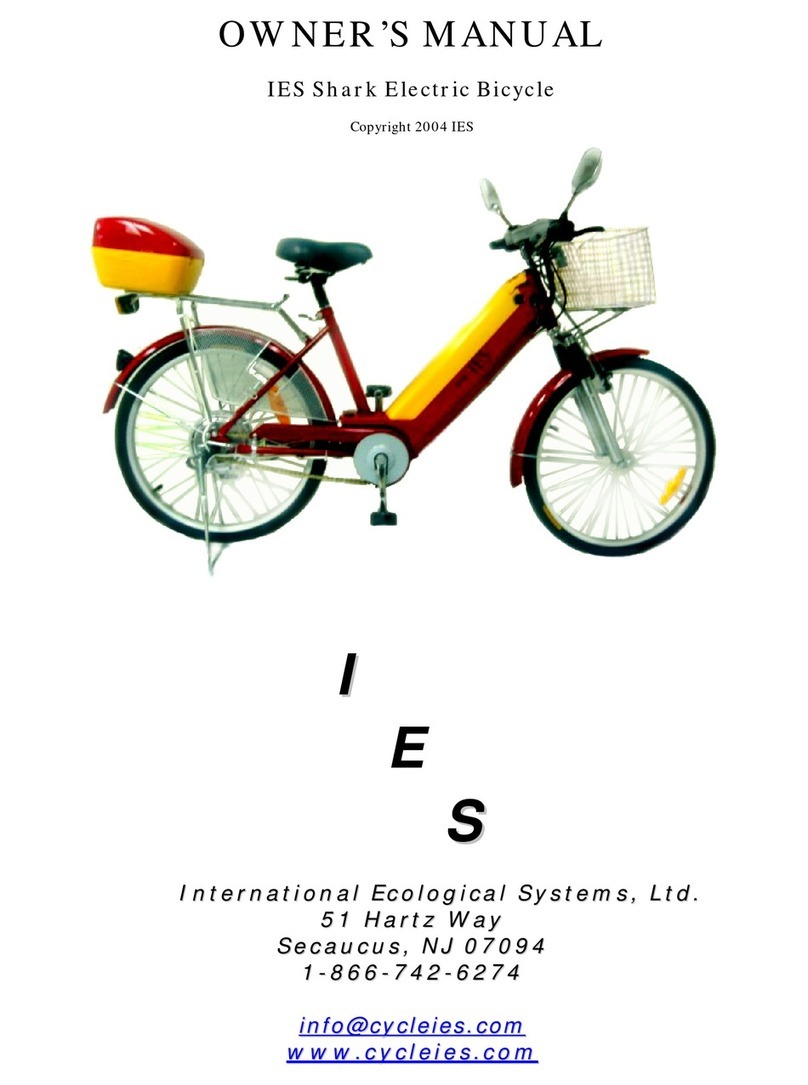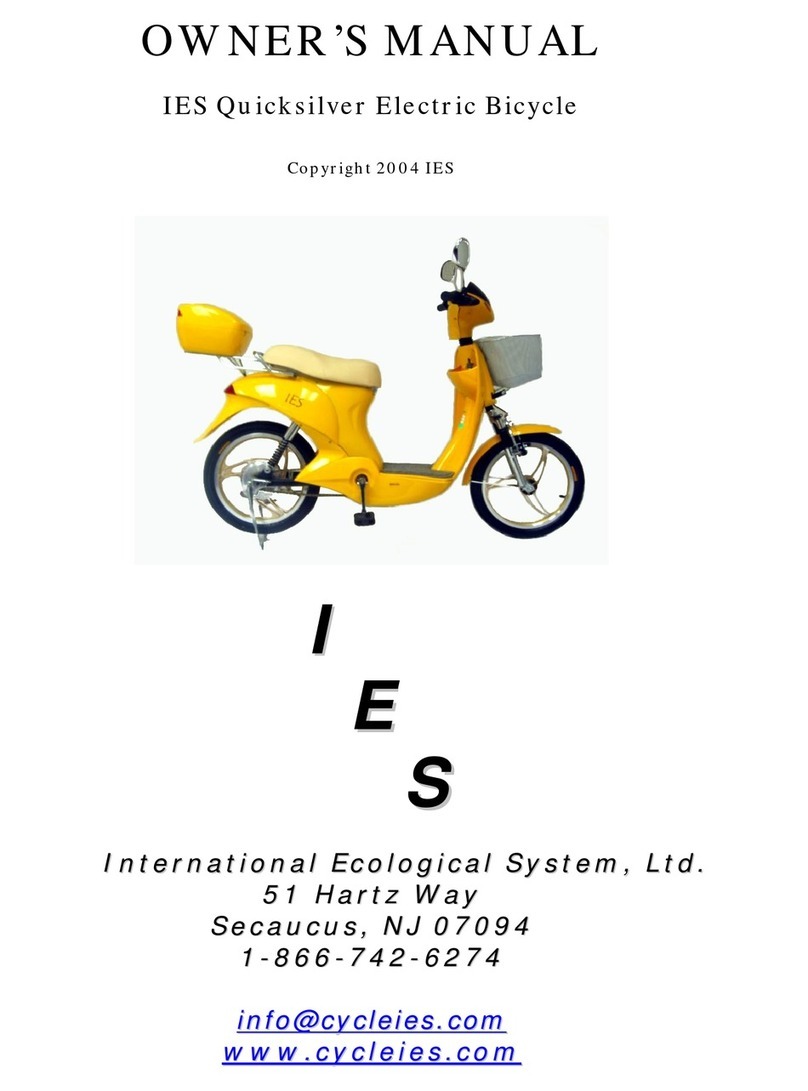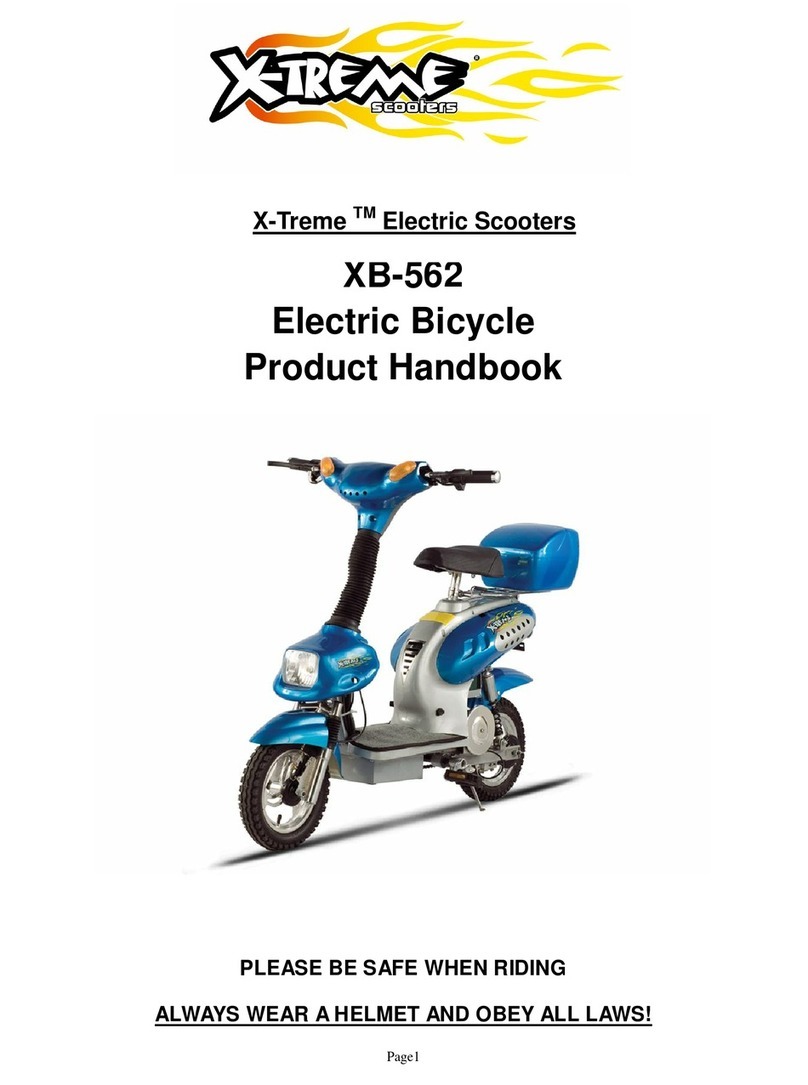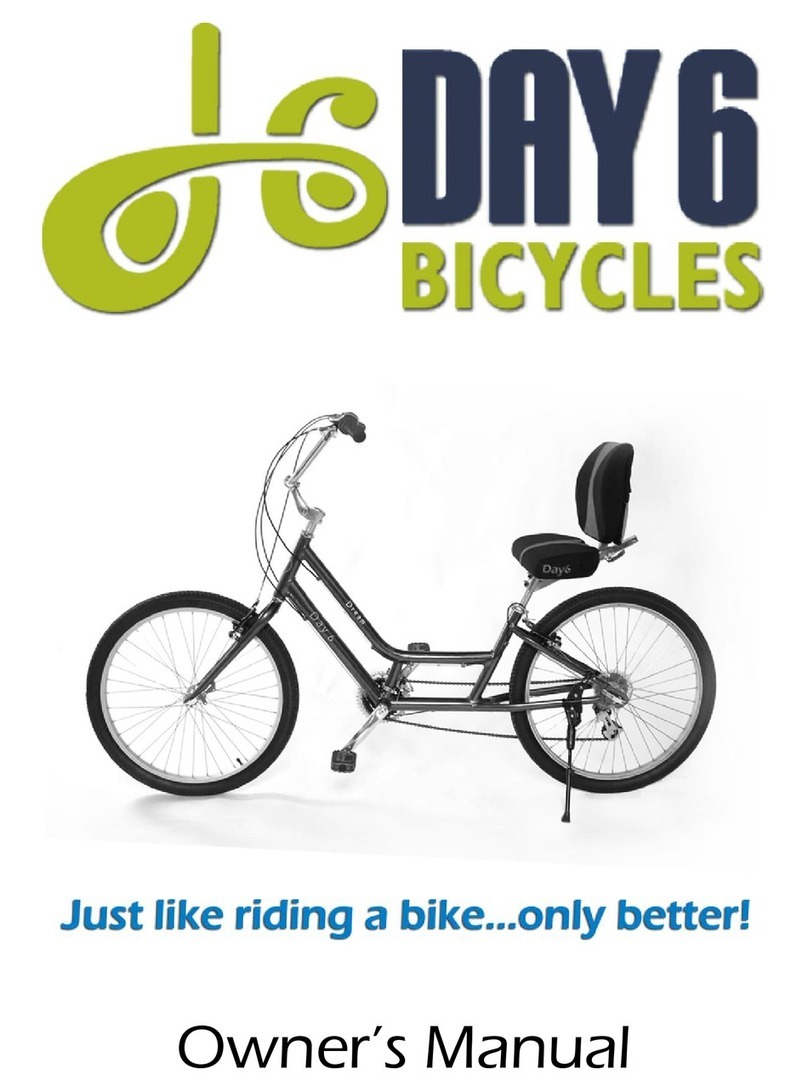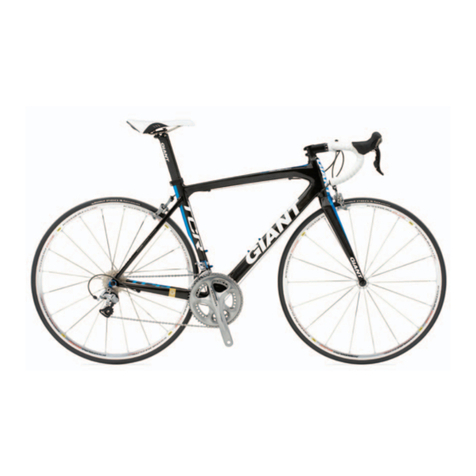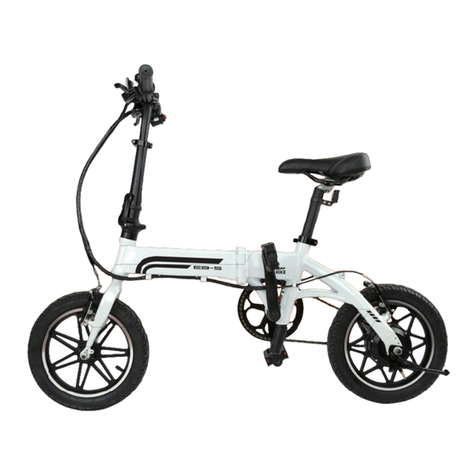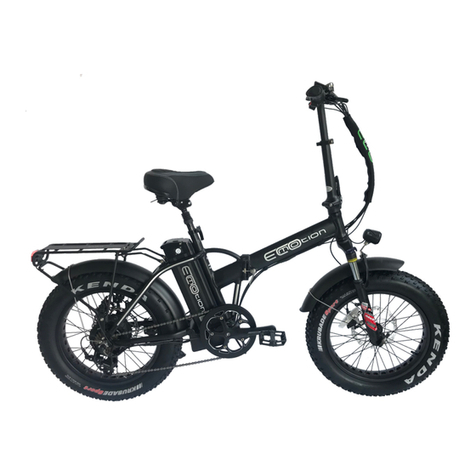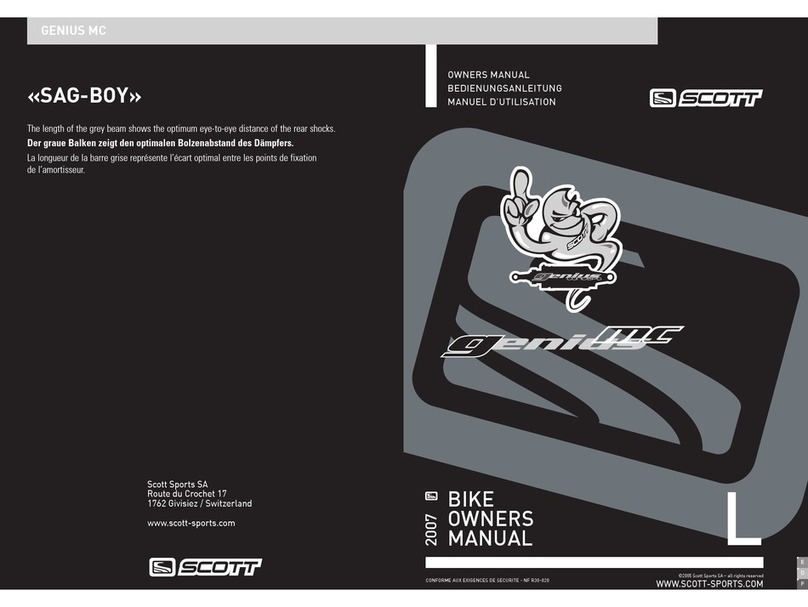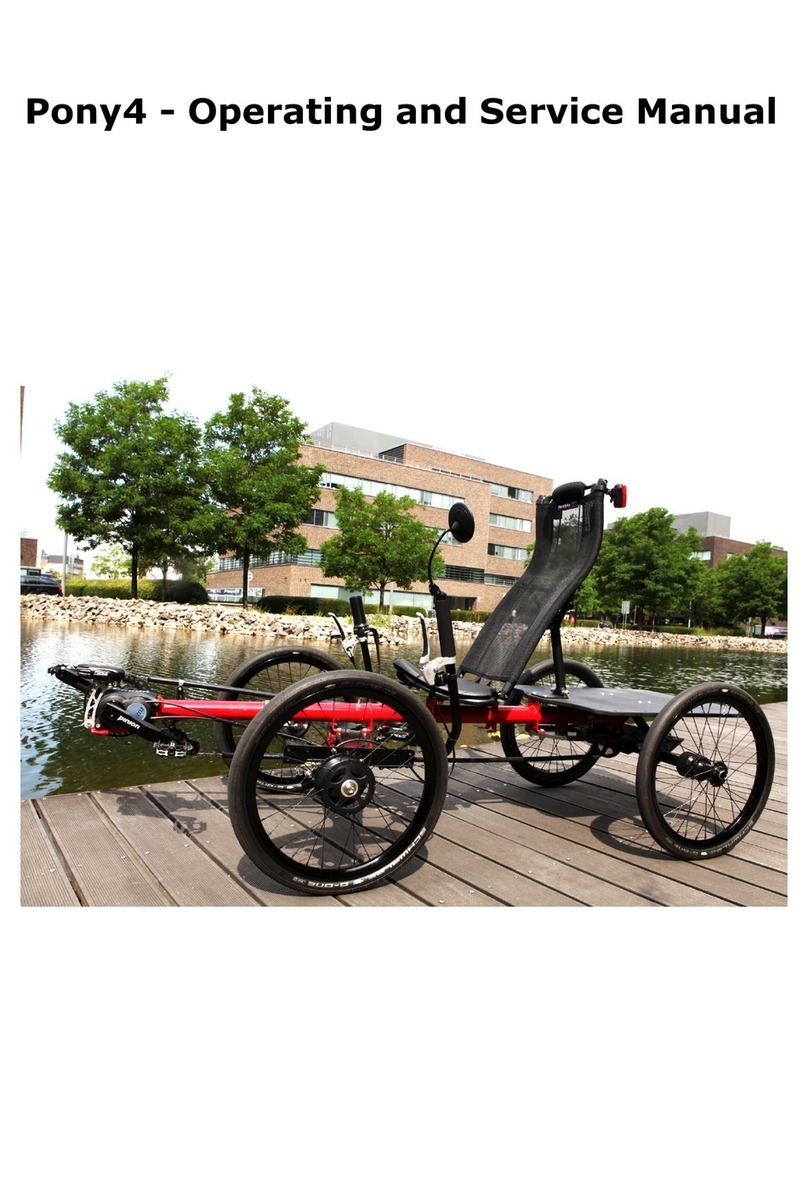IES Intrepid User manual

O
OW
WN
NE
ER
R’
’S
S
M
MA
AN
NU
UA
AL
L
I
IE
ES
S
I
In
nt
tr
re
ep
pi
id
d
E
El
le
ec
ct
tr
ri
ic
c
B
Bi
ic
cy
yc
cl
le
e
Copyright 2004 IES
I
I
E
S
S
International Ecological Systems, Ltd.
51 Hartz Way.
Secaucus, NJ 07094
1-866-742-6274
www.cycleies.com

O
OW
WN
NE
ER
R’
’S
S
M
MA
AN
NU
UA
AL
L
–
–
I
IE
ES
S
I
IN
NT
TR
RE
EP
PI
ID
D
I
IN
NT
TE
ER
RN
NA
AT
TI
IO
ON
NA
AL
L
E
EC
CO
OL
LO
OG
GI
IC
CA
AL
L
S
SY
YS
ST
TE
EM
MS
S,
,
L
LT
TD
D.
.
1
1-
-8
86
66
6-
-7
74
42
2-
-6
62
27
74
4
P
Pa
ag
ge
e
2
2
o
of
f
2
24
4
IMPORTANT!
Congratulations on selecting the IES Intrepid. In order to use and enjoy your bicycle
safely and to get the best performance and durability from this product, please read
this manual before riding.
Warning! Even on the best days, riding or operating any sort of vehicle is
hazardous. Always wear a helmet and use extra caution to avoid accidents.
This manual contains many cautions and warnings. It is important that you
read and understand the material outlined in this manual.
We want you to be completely satisfied with your Intrepid. If you have any questions or
concerns, please call the IES team at 1-866-742-6274.
Each bicycle comes with a Vehicle Identification Number (VIN) embossed into the
frame. Please record the VIN along with other pertinent information below in the event
that the bicycle is lost or stolen. It may also be a good idea to register your VIN number
with the local police department.
VIN:
Model:
Color:
Date of
Purchase:
Place of
Purchase:

O
OW
WN
NE
ER
R’
’S
S
M
MA
AN
NU
UA
AL
L
–
–
I
IE
ES
S
I
IN
NT
TR
RE
EP
PI
ID
D
I
IN
NT
TE
ER
RN
NA
AT
TI
IO
ON
NA
AL
L
E
EC
CO
OL
LO
OG
GI
IC
CA
AL
L
S
SY
YS
ST
TE
EM
MS
S,
,
L
LT
TD
D.
.
1
1-
-8
86
66
6-
-7
74
42
2-
-6
62
27
74
4
P
Pa
ag
ge
e
3
3
o
of
f
2
24
4
INTREPID
If you have any difficulty with the final assembly of your electric bike,
please call the IES Service Department at 1-866-726-6856.

O
OW
WN
NE
ER
R’
’S
S
M
MA
AN
NU
UA
AL
L
–
–
I
IE
ES
S
I
IN
NT
TR
RE
EP
PI
ID
D
I
IN
NT
TE
ER
RN
NA
AT
TI
IO
ON
NA
AL
L
E
EC
CO
OL
LO
OG
GI
IC
CA
AL
L
S
SY
YS
ST
TE
EM
MS
S,
,
L
LT
TD
D.
.
1
1-
-8
86
66
6-
-7
74
42
2-
-6
62
27
74
4
P
Pa
ag
ge
e
4
4
o
of
f
2
24
4
TABLE OF CONTENTS PAGE
•Record of serial number 2
•Photo of Intrepid 3
•Table of Contents 4
•Cautions and Warnings 5
•Inspection of your shipment 6
•Illustration of bike components 7
•Assembly Instructions 8
•Operating Instructions – Power 12
•Operating Instructions – Throttle and Controls 13
•Operating Instructions – Recharging the Battery 14
•Operating Instructions – Opening the Seat 17
•Illustrated Assembly Tips 18
•BicycleCare 19
•Safety Responsibility 20
•Bicycle Components 21
•Troubleshooting 23
•Specifications 24

O
OW
WN
NE
ER
R’
’S
S
M
MA
AN
NU
UA
AL
L
–
–
I
IE
ES
S
I
IN
NT
TR
RE
EP
PI
ID
D
I
IN
NT
TE
ER
RN
NA
AT
TI
IO
ON
NA
AL
L
E
EC
CO
OL
LO
OG
GI
IC
CA
AL
L
S
SY
YS
ST
TE
EM
MS
S,
,
L
LT
TD
D.
.
1
1-
-8
86
66
6-
-7
74
42
2-
-6
62
27
74
4
P
Pa
ag
ge
e
5
5
o
of
f
2
24
4
CAUTIONS AND WARNINGS!
Please read this section! It is very important for your safety and satisfaction
that you read these cautions and warnings. Thanks!
Warning! Always wear your helmet, obey local laws, and exercise
caution when riding.
Warning! If you are not certain that your bike is safe to ride, call the
IES Service Department at 1-866-726-6856 for detailed advice and
information.
Warning! Keep the power switched off until you are seated on the
bike and ready to ride. Turning the power on when not seated, and then
accidentally twisting the hand throttle can result in the bike accelerating or
“jumping” and cause damage or injury.
Warning! Never attempt to disassemble the battery, motor,
controller, or throttle. This can result in injury, fire, or damage to the bike.
Warning! Only use the charger that was supplied with your bike to
charge the battery. Use of an improper charger can result in fire or explosion.
Read and follow the charging instructions in the manual for complete
information about the operation of your charger.
Warning! Substituting batteries, changing motors or controllers will
void the warranty and may result in various types of safety problems
including fire, explosion, excessive speed, or lack of control. All service
should be performed by the IES Service Department or authorized dealer referred
by the IES Service Department.
Warning! Avoid contact with live wires, or the battery terminals.
Although the voltage is low, the amperage is high. Burns and other injuries can
result from contact with any body part.
Warning! Keep the battery and charger out of the reach of children.
Caution! Fully charge the battery before the first use. Failure to do this
can result in decreased battery performance for the life of the bike. Fully charge
the battery each time you use the bike.
Caution! Do not store your new bike where it will be exposed to high
heat, high humidity, or rain for extended periods. All of these will
decrease the life and appearance of your bike.
Caution! Do not immerse your bike in water especially sea water. This
can damage or destroy the electrical components.

O
OW
WN
NE
ER
R’
’S
S
M
MA
AN
NU
UA
AL
L
–
–
I
IE
ES
S
I
IN
NT
TR
RE
EP
PI
ID
D
I
IN
NT
TE
ER
RN
NA
AT
TI
IO
ON
NA
AL
L
E
EC
CO
OL
LO
OG
GI
IC
CA
AL
L
S
SY
YS
ST
TE
EM
MS
S,
,
L
LT
TD
D.
.
1
1-
-8
86
66
6-
-7
74
42
2-
-6
62
27
74
4
P
Pa
ag
ge
e
6
6
o
of
f
2
24
4
INSPECTION OF YOUR SHIPMENT
The following is a list of all the necessary parts and components of your new Intrepid.
Please make sure the listed parts are enclosed in the boxes and in good working
condition.
Bicycle
2 Pedals
Battery Charger and Power Cord
Battery
Allen Wrench
Open end / box combination wrench
Philips head screwdriver
Front Wheel
Front Fender
Front Basket and Parts
Keys
Rear Locking Carrier
2 Rear View Mirrors
Assorted nuts, bolts, washers and screws
Owner’s Manual
Please check the bike along with the parts and components thoroughly for any damage
that may have occurred during shipping. Be careful to avoid scratching the frame when
untying or unpacking the bicycle and components.
If you find that something is missing, please call the IES team at 1-866-742-6274.

O
OW
WN
NE
ER
R’
’S
S
M
MA
AN
NU
UA
AL
L
–
–
I
IE
ES
S
I
IN
NT
TR
RE
EP
PI
ID
D
I
IN
NT
TE
ER
RN
NA
AT
TI
IO
ON
NA
AL
L
E
EC
CO
OL
LO
OG
GI
IC
CA
AL
L
S
SY
YS
ST
TE
EM
MS
S,
,
L
LT
TD
D.
.
1
1-
-8
86
66
6-
-7
74
42
2-
-6
62
27
74
4
P
Pa
ag
ge
e
7
7
o
of
f
2
24
4
FIGURE 1 – Parts of your Intrepid
2
4
5 7
8
9
12
11
13
15
16
19
20
18
23
24
27
26
6
1
25
10
14
3
22
17
21
1 -
Front Brake Lever 11 -
Battery Indicator 21 -
Rear Brake
2 -
Rear Brake Lever 12 -
Battery (Under Mat) 22 -
Rear locking Carrier
3 -
Reflectors 13 -
Kickstand 23 -
Rear Wheel Lug nuts
4 -
Handlebar 14 -
Pedal 24 -
Gears
5 -
Front Brake 15 -
Crank Arm 25 -
Charging Port
6 -
Handlebar Stem 16 -
Chain Wheel 26 -
Power On/Off
7 -
Frame Tubes 17 -
Wire harness 27 -
Display
8 -
Front Fork Assembly 18 -
Motor
9 -
Tire (Front & Rear) 19 -
Seat Riser
10 -
Rim (Front & Rear) 20 -
Saddle

O
OW
WN
NE
ER
R’
’S
S
M
MA
AN
NU
UA
AL
L
–
–
I
IE
ES
S
I
IN
NT
TR
RE
EP
PI
ID
D
I
IN
NT
TE
ER
RN
NA
AT
TI
IO
ON
NA
AL
L
E
EC
CO
OL
LO
OG
GI
IC
CA
AL
L
S
SY
YS
ST
TE
EM
MS
S,
,
L
LT
TD
D.
.
1
1-
-8
86
66
6-
-7
74
42
2-
-6
62
27
74
4
P
Pa
ag
ge
e
8
8
o
of
f
2
24
4
ASSEMBLY INSTRUCTIONS
Tools Required For Assembly
This bicycle can be assembled with the following tools which are included in the shipping carton.
- metric Allen wrenches
- combination open end/box wrench
- Phillips screwdriver
Assembly Instructions
Please read through and follow all instructions to ensure that your Intrepid is properly
assembled and ready for use.
1. Remove the bicycle from the box by cutting the plastic strapping, then cutting two
sides of the box away. Avoid lifting the bike straight up out of the box. Remove all
of the wrappings and ties that protect the bicycle during shipment.
2. Attaching the front wheel and fender.
a) First loosen the front brake assembly by loosening the knurled nut (as
shown in figure on Page 10) so the brake pads can be easily moved.
b) Loosen the washer and locking nut on the front wheel bolt and position the
front wheel on the front fork assembly, making sure that the washer and
locking nut are positioned on the outside of the front fork assembly.
c) Install the front fender. Remove the screw from the center front of the
front brake assembly, reattach the screw through the fender clip. Attach
the fender supports with screws to the front fork assembly as shown in
Figure 1.
Figure 1 Attaching front fender.

O
OW
WN
NE
ER
R’
’S
S
M
MA
AN
NU
UA
AL
L
–
–
I
IE
ES
S
I
IN
NT
TR
RE
EP
PI
ID
D
I
IN
NT
TE
ER
RN
NA
AT
TI
IO
ON
NA
AL
L
E
EC
CO
OL
LO
OG
GI
IC
CA
AL
L
S
SY
YS
ST
TE
EM
MS
S,
,
L
LT
TD
D.
.
1
1-
-8
86
66
6-
-7
74
42
2-
-6
62
27
74
4
P
Pa
ag
ge
e
9
9
o
of
f
2
24
4
Installing the front wheel and fender supports.
3. Install the pedals. Install the pedals by carefully threading through crank arm,
then tightening securely with a wrench
4. Adjusting the Brakes - Adjust the front brake by first loosening the nut on
brake assembly as shown in figure which follows on Page 10. Read below section
on brake testing. If brake tension is too lose, pull inner wire cable towards you,
then tighten nut. If brake tension is too tight, release inner wire cable until you
achieve proper tension, then tighten nut. When you have determined the proper
setting, turn the knurled knob at the shaft of the adjusting bolt all the way down to
the brake lever to lock the brake setting in place. (See section which follows on
brake testing) You may also adjust the front brake pad distance to the rim using
an Allen wrench as shown. Loosen brake screw and position pad so it does not
touch rim, then tighten screw.
The right brake lever controls the rear brake. The rear band brake has been pre-
adjusted at the factory.
Brake Testing
Squeeze the brake levers. The brake levers should be easy for you to reach, and
engage the brakes completely when pulled in. You should not be able to pull the
brake lever in until it touches the handlebar or grip. Test the brakes and the brake
lever adjustment; you should be able to comfortably control your brakes. If the
brake adjustment is too loose, the extra play will cause insufficient braking power.
The play is properly adjusted if the brake pads of the front brake meet the rim
fully when the brake lever is pulled one-third of the way.
If you have any questions, please call our Service Department at 1-866-726-6856.

O
OW
WN
NE
ER
R’
’S
S
M
MA
AN
NU
UA
AL
L
–
–
I
IE
ES
S
I
IN
NT
TR
RE
EP
PI
ID
D
I
IN
NT
TE
ER
RN
NA
AT
TI
IO
ON
NA
AL
L
E
EC
CO
OL
LO
OG
GI
IC
CA
AL
L
S
SY
YS
ST
TE
EM
MS
S,
,
L
LT
TD
D.
.
1
1-
-8
86
66
6-
-7
74
42
2-
-6
62
27
74
4
P
Pa
ag
ge
e
1
10
0
o
of
f
2
24
4
Adjusting the front brake
5. Install the battery as indicated in Figure 2. Connect the power cable to the
battery. Lock the battery in place using the key.
Figure 2
6. Install the front basket as shown in Figure 3. Remove the Phillips head screw
beneath the front headlight from the front bike frame. Place basket on front basket
support, reattach Phillips head screw through basket frame. Install screw and
washer through bottom basket screw holes into clamp which is attached beneath
the front basket support.
7. Install the rear locking carrier (See illustration below) Align the three holes in the
bottom of the rear carrier with the holes in the rear bracket. Insert screw and
washer through rear carrier bottom and rear bracket. Secure with a nut on each
screw.

O
OW
WN
NE
ER
R’
’S
S
M
MA
AN
NU
UA
AL
L
–
–
I
IE
ES
S
I
IN
NT
TR
RE
EP
PI
ID
D
I
IN
NT
TE
ER
RN
NA
AT
TI
IO
ON
NA
AL
L
E
EC
CO
OL
LO
OG
GI
IC
CA
AL
L
S
SY
YS
ST
TE
EM
MS
S,
,
L
LT
TD
D.
.
1
1-
-8
86
66
6-
-7
74
42
2-
-6
62
27
74
4
P
Pa
ag
ge
e
1
11
1
o
of
f
2
24
4
8.
9. Install the rear view mirrors as shown in Figure 4. Install the mirrors to the front
handlebar assembly. Remove the screw and nut from the right and left brake lever
as shown. Slide the mirror through the screw hole and tighten the nut securely.
(You do not need the screw which you have removed once mirrors have been
attached)
See the “Assembly Tips” section of this book for pictures showing assembly tips for your
bike.
F
ill tires with air to the recommended pressure 40-PSI and charge the battery before riding.
Local bicycle shops are usually willing to assemble bicycles for a fee. They will often check a
bicycle for safety at no charge.
If you have any questions, call the IES Service Department at: 1-(866) 726-6856.

O
OW
WN
NE
ER
R’
’S
S
M
MA
AN
NU
UA
AL
L
–
–
I
IE
ES
S
I
IN
NT
TR
RE
EP
PI
ID
D
I
IN
NT
TE
ER
RN
NA
AT
TI
IO
ON
NA
AL
L
E
EC
CO
OL
LO
OG
GI
IC
CA
AL
L
S
SY
YS
ST
TE
EM
MS
S,
,
L
LT
TD
D.
.
1
1-
-8
86
66
6-
-7
74
42
2-
-6
62
27
74
4
P
Pa
ag
ge
e
1
12
2
o
of
f
2
24
4
OPERATING INSTRUCTIONS - Power
Before You Ride
Make sure all parts, components and accessories are in good working order. Check all
fittings and be sure that they are tight and secure. Inspect your bike completely.
Power On/Off
The Power On/Off switch is a key switch located on the bicycle frame. The Intrepid uses
the same key to lock the battery box and accessory box.
Insert the key into the ignition key switch.
Turn the key clockwise.
Computer / Display
You will find 5 lights which indicate battery
strength. When all 5 lights are on, the battery is fully
charged.
Always turn the ignition switch to the ‘off’ position if you are not using the electric bike.
Notes:
Do not recharge your battery until at least 3 of 5 battery level indicators are off.

O
OW
WN
NE
ER
R’
’S
S
M
MA
AN
NU
UA
AL
L
–
–
I
IE
ES
S
I
IN
NT
TR
RE
EP
PI
ID
D
I
IN
NT
TE
ER
RN
NA
AT
TI
IO
ON
NA
AL
L
E
EC
CO
OL
LO
OG
GI
IC
CA
AL
L
S
SY
YS
ST
TE
EM
MS
S,
,
L
LT
TD
D.
.
1
1-
-8
86
66
6-
-7
74
42
2-
-6
62
27
74
4
P
Pa
ag
ge
e
1
13
3
o
of
f
2
24
4
OPERATING INSTRUCTIONS – Throttle & Controls
The throttle is located on the right side of the handlebar
. Hold it with your right hand and turn it towards your
body (counter clockwise) to increase speed.
L·R switch: Right & Left turn signal.
Red light switch: Front & rear light. When braking the rear light
works as a brake light
Green switch: Horn
Caution: we recommend you ride at a slow speed until you become familiar with operation
of the electric bike.

O
OW
WN
NE
ER
R’
’S
S
M
MA
AN
NU
UA
AL
L
–
–
I
IE
ES
S
I
IN
NT
TR
RE
EP
PI
ID
D
I
IN
NT
TE
ER
RN
NA
AT
TI
IO
ON
NA
AL
L
E
EC
CO
OL
LO
OG
GI
IC
CA
AL
L
S
SY
YS
ST
TE
EM
MS
S,
,
L
LT
TD
D.
.
1
1-
-8
86
66
6-
-7
74
42
2-
-6
62
27
74
4
P
Pa
ag
ge
e
1
14
4
o
of
f
2
24
4
OPERATING INSTRUCTIONS – Charging the battery
CAUTION: Do not attempt to open or tamper with the battery in any way. Doing so
may cause chemical, electrical and/or fire hazards.
Batteries that lay dormant for an extended period of time will lose their ability to accept
a charge. Please make sure you ride and recharge your bike periodically to prevent this
from happening. Charge the batteries every two months, even if the bike is not being
used.
If you let your battery completely discharge due to prolonged storage and lack of use, it
can become damaged and may need to be replaced.
Recharging the Batteries
It is important that you charge your batteries after every use when two or
more lights of the battery display have gone out. This will extend the total life of
your battery. Once the charger has indicated that the battery is fully charged, unplug
the power source from the bicycle and from the electrical outlet. It is best for the battery
to be stored in a cool place (59°- 86°F or 15°- 30°C) with 10% - 70% humidity. Do not
leave the battery charger plugged in for long periods of time (more than 10 hours). This
can damage the batteries.
Do not remove the battery box from the bicycle frame while recharging to
avoid damaging charging cables. You can, however, remove the battery from the
bike after you have turned the power off. To remove the battery, unplug the power
cord and lift the battery by the handle. Once the battery has been completely
removed from the bike, it can be charged independently.
To charge your batteries:
1. Turn the on/off power switch on your bike to the “off” position.
2. Insert the charger’s plug into the battery box charging port. (see illustration on
page 15)
3. Plug the battery charger into the wall outlet.
4. Turn the charger on.
5. The charger will take 6-8 hours to recharge the battery completely. When the
green light appears the battery is sufficiently charged. If possible, continue to
charge the battery for 2-4 hours additional, when possible.
6. Do not charge for more than 10 hours – to avoid overcharging and damaging the
battery, especially in hot weather.
7. Charge the bike in a dry and clean place. Keep the charger dry and clean.
8. The charger will become warm during charging.
9. You can also charge the battery when it has been removed from the bike.

O
OW
WN
NE
ER
R’
’S
S
M
MA
AN
NU
UA
AL
L
–
–
I
IE
ES
S
I
IN
NT
TR
RE
EP
PI
ID
D
I
IN
NT
TE
ER
RN
NA
AT
TI
IO
ON
NA
AL
L
E
EC
CO
OL
LO
OG
GI
IC
CA
AL
L
S
SY
YS
ST
TE
EM
MS
S,
,
L
LT
TD
D.
.
1
1-
-8
86
66
6-
-7
74
42
2-
-6
62
27
74
4
P
Pa
ag
ge
e
1
15
5
o
of
f
2
24
4
OPERATING INSTRUCTIONS – Charging the battery (continued)
Precautions while recharging the Batteries
1. Using your power source incorrectly or leaving the power source connected to the
bicycle and plugged into an AC power source for extended periods of time can
result in a fire.
2. Always use your charger as instructed.
3. Do not use any other charger than the one that came with your Intrepid.
4. Avoid any contact with water when recharging your battery. If a plug or socket
should get wet, dry it thoroughly before proceeding.
5. Do not recharge your battery in direct sunlight or in any very hot environment.
6. Be sure to keep pets and small children away from the area where you are
recharging.
7. To avoid damage to the integrated charger, never subject it to intense physical
shock or constant vibration.
8. You can charge your battery independently of the bike.
Please contact the IES Service Department at 1-866-726-6856 if you have
the wrong charger or if it is not functioning properly.

O
OW
WN
NE
ER
R’
’S
S
M
MA
AN
NU
UA
AL
L
–
–
I
IE
ES
S
I
IN
NT
TR
RE
EP
PI
ID
D
I
IN
NT
TE
ER
RN
NA
AT
TI
IO
ON
NA
AL
L
E
EC
CO
OL
LO
OG
GI
IC
CA
AL
L
S
SY
YS
ST
TE
EM
MS
S,
,
L
LT
TD
D.
.
1
1-
-8
86
66
6-
-7
74
42
2-
-6
62
27
74
4
P
Pa
ag
ge
e
1
16
6
o
of
f
2
24
4
OPERATING INSTRUCTIONS – Charging the battery (illustrations)
You may charge the battery without removing it from the
bike or you may remove the battery for charging. Make
sure ignition is turned off before charging.
To charge the battery without removing from the bike,
locate the charging port, located on the seat riser.
Insert the charger plug into the charging port.
Battery Charger Status Lights
•When power source is ‘on’ but not connected to the battery,
the Indicator light on the charger will be orange.
•When all cables are properly connected, the indicator light
on the Charger will turn red if the battery energy supply is
low, and charging process has begun.
•When the green indicator lights up after 6-8 hours of
charging time, it means the battery is sufficiently charged.
If the battery does not charge, the battery fuse may be blown.
Replace the fuse by unscrewing the fuse cap, inserting a new
fuse in the cap and screwing the fuse cap back into the battery.
Note: When the battery is fully charged, it produces more voltage than the head light is rated to
handle. We recommend waiting 10 minutes after the charging is complete before you ride your
bike, or turn on the lights.
You must lock the battery box before turning on the electric bicycle to ensure the battery
is properly connected.

O
OW
WN
NE
ER
R’
’S
S
M
MA
AN
NU
UA
AL
L
–
–
I
IE
ES
S
I
IN
NT
TR
RE
EP
PI
ID
D
I
IN
NT
TE
ER
RN
NA
AT
TI
IO
ON
NA
AL
L
E
EC
CO
OL
LO
OG
GI
IC
CA
AL
L
S
SY
YS
ST
TE
EM
MS
S,
,
L
LT
TD
D.
.
1
1-
-8
86
66
6-
-7
74
42
2-
-6
62
27
74
4
P
Pa
ag
ge
e
1
17
7
o
of
f
2
24
4
OPERATING INSTRUCTIONS – Opening the seatOPERATING INSTRUCTIONS – Opening the seat
Insert the key into the switch under the seat and
turn clockwise.
Note: This key also operates the ignition
Lift the seat from the rear. This compartment
can be used for storage
When you close the seat, press down on the rear
of the seat with your hand. Ensure the seat
is properly latched.

O
OW
WN
NE
ER
R’
’S
S
M
MA
AN
NU
UA
AL
L
–
–
I
IE
ES
S
I
IN
NT
TR
RE
EP
PI
ID
D
I
IN
NT
TE
ER
RN
NA
AT
TI
IO
ON
NA
AL
L
E
EC
CO
OL
LO
OG
GI
IC
CA
AL
L
S
SY
YS
ST
TE
EM
MS
S,
,
L
LT
TD
D.
.
1
1-
-8
86
66
6-
-7
74
42
2-
-6
62
27
74
4
P
Pa
ag
ge
e
1
18
8
o
of
f
2
24
4
ASSEMBLY TIPS
Figure 3 Attaching the front basket.
Screw basket into
handlebar assembly Attach basket to bracket using 2 screws and bolts
Figure 4 Installing the Rear-View Mirrors
a)
b)
a) Remove the screw and nut from the right and left brake lever as shown.
b) Slide the mirror through the screw hole and tighten the nut securely. (You do not
need the screw which you have removed once mirrors have been attached)

O
OW
WN
NE
ER
R’
’S
S
M
MA
AN
NU
UA
AL
L
–
–
I
IE
ES
S
I
IN
NT
TR
RE
EP
PI
ID
D
I
IN
NT
TE
ER
RN
NA
AT
TI
IO
ON
NA
AL
L
E
EC
CO
OL
LO
OG
GI
IC
CA
AL
L
S
SY
YS
ST
TE
EM
MS
S,
,
L
LT
TD
D.
.
1
1-
-8
86
66
6-
-7
74
42
2-
-6
62
27
74
4
P
Pa
ag
ge
e
1
19
9
o
of
f
2
24
4
BICYCLE CARE
We recommend having your Shadow serviced once a year by a bicycle mechanic for
regular bicycle maintenance in order to ensure safety and keep components in proper
working order.
Throughout the year, there are simple steps you can take to inspect and maintain your
Intrepid:
1. Every week or two, tighten all nuts and bolts. Check all hardware to see that no
parts are worn, damaged, or missing. Make certain that the frame and fork
alignment are true and that all components are seated in the correct position.
2. Clean the frame and all parts regularly with a moist cloth or sponge. Remove the
battery and turn off the power before cleaning. Do not completely immerse the
bicycle in water and avoid using a hose and soaking the battery and motor area.
Be sure to completely dry your bike with a soft towel to prevent rusting and
corrosion. Your Intrepid is water resistant, but not waterproof.
3. Reflectors should be kept clean, securely fastened and positioned for easy
visibility at night from the front, rear and side. Immediately replace any damaged
reflectors. ALWAYS USE A FRONT AND REAR LIGHT WHEN RIDING
AT NIGHT. Check your local regulations for specific requirements.
4. Replace worn or damaged cables. Do not kink cables.
5. Cables stretch with use - adjust accordingly.
6. Replace worn grips. Make sure they fit snugly.
7. Check the chain tension frequently and keep it adjusted.

O
OW
WN
NE
ER
R’
’S
S
M
MA
AN
NU
UA
AL
L
–
–
I
IE
ES
S
I
IN
NT
TR
RE
EP
PI
ID
D
I
IN
NT
TE
ER
RN
NA
AT
TI
IO
ON
NA
AL
L
E
EC
CO
OL
LO
OG
GI
IC
CA
AL
L
S
SY
YS
ST
TE
EM
MS
S,
,
L
LT
TD
D.
.
1
1-
-8
86
66
6-
-7
74
42
2-
-6
62
27
74
4
P
Pa
ag
ge
e
2
20
0
o
of
f
2
24
4
SAFETY RESPONSIBILITY
Know the laws of your state. It is your responsibility to know and obey the laws of your
local area concerning the operation of an electric bicycle. Laws which apply to regular
bicycles also govern the use of electric bikes. In some cities and towns, local laws may
also apply. You can check with your local police department for information on local
laws.
There are also some common sense rules to keep in mind as you are preparing to ride
and as you are riding.
1. Wear your helmet at all times. This is required by law in some states and is an
important precaution in all states. Always use a helmet that fits and is approved for
such use. Keep the chinstrap fastened. HELMETS CAN HELP PREVENT
HEAD INJURIES IN THE EVENT OF AN ACCIDENT.
2. Only one rider at a time. Riding double or carrying large objects that obstruct your
vision or interfere with your control of the vehicle can result in loss of control.
3. Ride with traffic and obey all traffic laws.
4. Do not perform tricks or stunts. Maintain complete control, caution and a
reasonable speed at all times. This bicycle is not suited for stunt jumping,
competition or racing. Never allow other vehicles to tow the bicycle.
5. When riding at night or in inclement weather, always use lights that are bright and
in good working order. Use the clear light on the front and the red light on the back
of your Intrepid, which your Intrepid is equipped with. Wear light colored and/or
reflective clothing. Assume motorists are unable to see you and ride in a very
defensive, cautious manner.
6. Take special precautions when riding in the rain, ice or snow. Give yourself more
time and room to brake. Ride slower than normal in order to keep full control of
your bicycle. It is also difficult for motorists to see you when it is raining or
snowing; take care when riding in inclement weather.
7. Watch for cars pulling out in front of you and the sudden opening of car doors.
8. Give pedestrians the right of way and be sure to (bell, horn, voice, etc.) alert them to
your presence to avoid any type of collision.
This manual suits for next models
1
Table of contents
Other IES Bicycle manuals
Popular Bicycle manuals by other brands
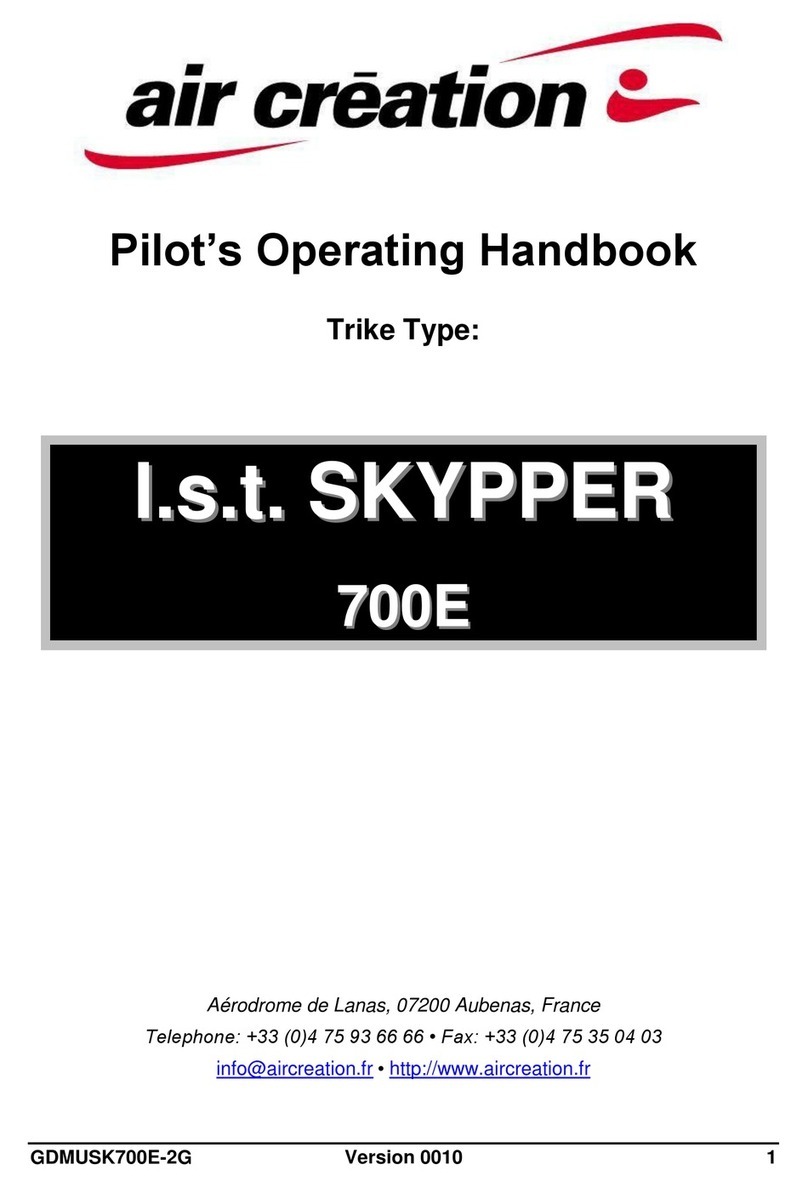
Air Creation
Air Creation l.s.t. SKYPPER 700E Pilot operating handbook
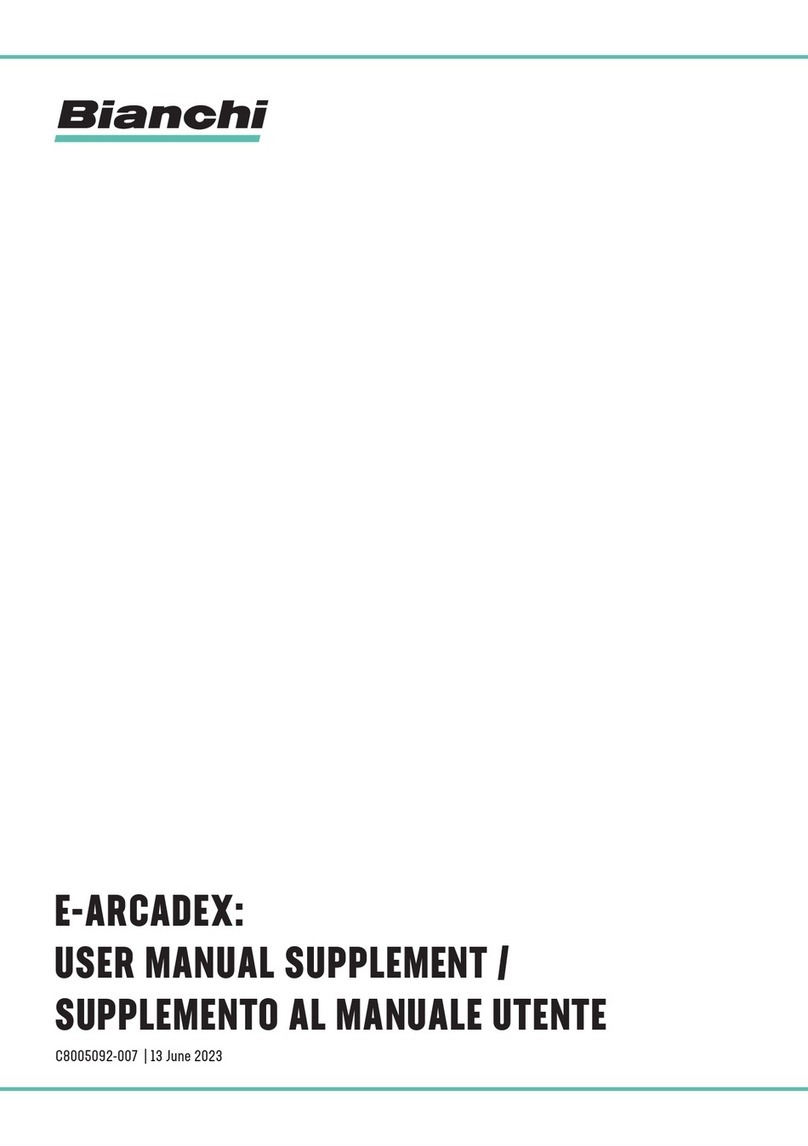
Bianchi
Bianchi E-ARCADEX User's manual supplement

Woosh
Woosh Sirocco 2 user manual

Fisher-Price
Fisher-Price Barbie Free Spirit Trike 72639 instructions

Matrix
Matrix R7XE-03 Bike Service manual
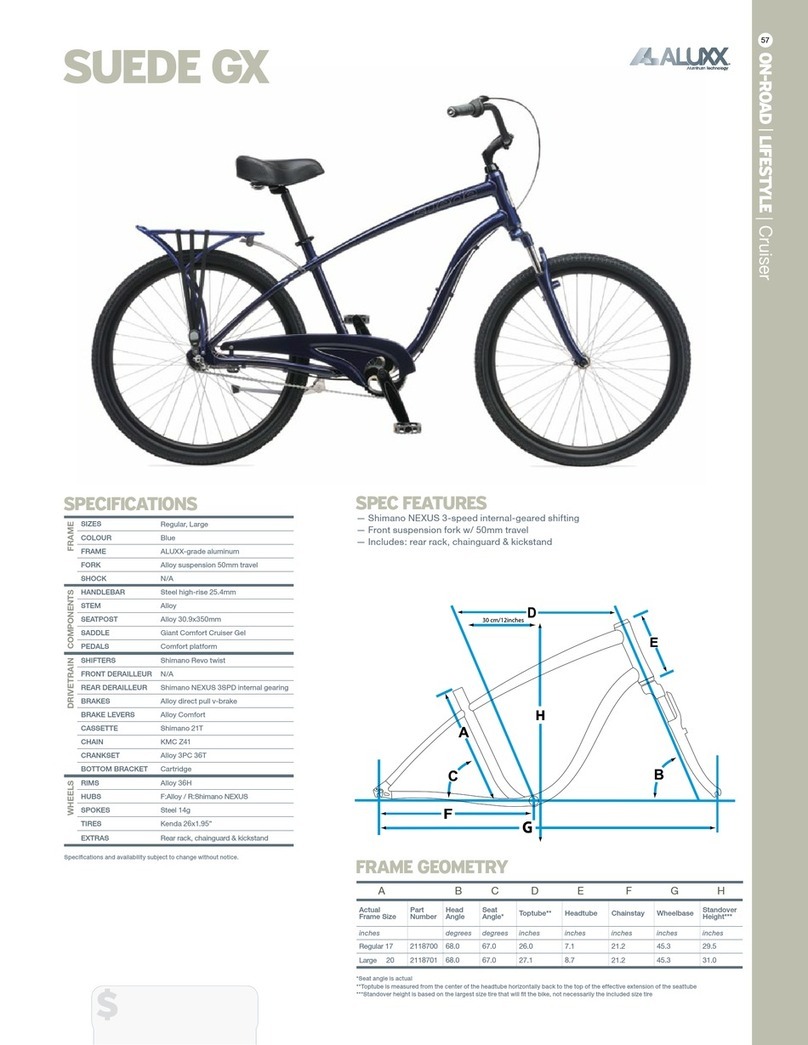
Giant
Giant SUEDE GX - DATASHEET 2 datasheet



